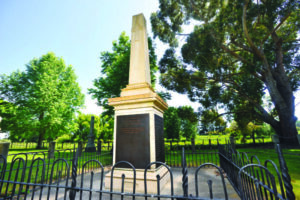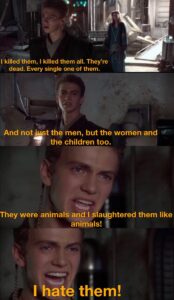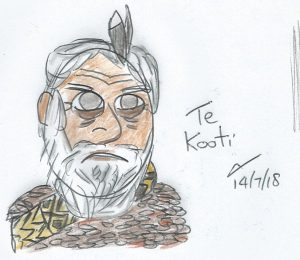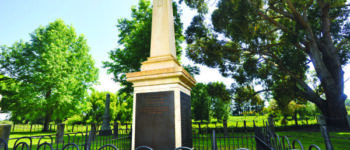1868: The Poverty Bay Massacre
November 10, 2021
By AHNZ
 Today in history, 9 November, 1868, Te Kooti Arikirangi Te Turuki led a massacre upon the people living at what we today know as Gisbourne (The killings took place in the early hours of 10 November.)
Today in history, 9 November, 1868, Te Kooti Arikirangi Te Turuki led a massacre upon the people living at what we today know as Gisbourne (The killings took place in the early hours of 10 November.)
Earlier, in July, Te Kooti had led some 320 men, women, and children out of the prisoner islands to freedom. In a daring jail break, Te Kooti’s band hijacked the ship Rifleman and sailed to to Poverty Bay from the Chatham Islands.
Captivity had made him a mystic. Liberty now made Te Kooti a warlord. Now leader of the Hau Hau Cult, Te Kooti had a New Zealand Kristallnacht to unleash on November 9th exactly 70 years before Adolf Hitler’s Brown Shirts would be doing the same in Nazi Germany.
Consolidated after winter and still at large, Te Kooti now embarked on a Roaring Rampage of Revenge with the Poverty Bay Massacre (aka Matawhero Massacre.) Some 50 men, women, and children were systematically stalked and slaughtered. The victims were equally Settler and Maori. It is one of the greatest atrocities in New Zealand history in terms of raw murdering.
Te Kooti was never brought to justice for the blood he spilled on what he claimed was his land. He even had the gall, in 1889, to lead a march of his followers back to Gisbourne which caused a great stir.
“The drunken old warlord mystic with a large cavalcade behind him trying to return to the scene of his jail break. The people of Gisbourne did not want the killer of their kin back in their town. Would you?” – 1889: Te Kooti’s Homecoming, AHNZ
 Te Kooti’s true enemy, the enemy of us all, was not his victims but the people who called themselves The Government. Even Kooti’s great foe, Gilbert Mair, admitted that “So far as Te Kooti’s guilt was concerned, I am perfectly certain that no charge could have been sustained against him in any court of competent jurisdiction prior to his deportation, untried, to the Chathams.” Te Kooti used to be on the side of The State but was rejected as a spy then, untried, incarcerated by the government monsters whereupon he became one himself.
Te Kooti’s true enemy, the enemy of us all, was not his victims but the people who called themselves The Government. Even Kooti’s great foe, Gilbert Mair, admitted that “So far as Te Kooti’s guilt was concerned, I am perfectly certain that no charge could have been sustained against him in any court of competent jurisdiction prior to his deportation, untried, to the Chathams.” Te Kooti used to be on the side of The State but was rejected as a spy then, untried, incarcerated by the government monsters whereupon he became one himself.
New Zealand historians have various things to say about the massacre, from apologetics to condemnation. Characteristically, Alison Dench (2005) whitewashes the killing by simply saying “Te Kooti’s Ringatu forces attack..and take control of the area.”
Downie Stewart (1940) said Te Kooti’s war party massacred all Europeans they could find. Sparing no man, woman, or child.
“Captain Wilson, who was carrying one of the children, was bayoneted in the back, and fell dead with the little boy in his arms. Mrs. Wilson was then savagely bayoneted, and was left for dead, stabbed in several places. Three of the children and the servant Moran were killed; the little boy, James Wilson…hid in the scrub, and after wandering about for two days he returned and discovered his mother still alive; she had crawled into a shed…but died from her terrible wounds.” – Cowan (1956)
Judith Binney in the 1990s advocated for the old warlord mystic that he had a just plan all along, that it was no random massacre at all. She said that Te Kooti’s killings were restricted to the people on his land or land in which he had ‘interests’. As for the women and children, Binney’s opinion was that this was how Maoris behaved in the late 1860s.1
“Several fugitives owed their lives to the heroism of a friendly chief, Tutari, who refused to gain his life by telling their pursuers the path they had taken. The Hau-Hau killed him and seized his wife, who, however, adroitly saved both the flying settlers and herself by pointing out the wrong track.” – Reeves (1898)
 “On the night of November 10th, 1868, the rebels came down from the Urewera country and fell upon the settlers of Matawhero, near Gisbourne. Thirty-two white people as well as a number of friendly natives perished on that dreadful night.”- Our Nation’s Story (c.1940)
“On the night of November 10th, 1868, the rebels came down from the Urewera country and fell upon the settlers of Matawhero, near Gisbourne. Thirty-two white people as well as a number of friendly natives perished on that dreadful night.”- Our Nation’s Story (c.1940)
“The tenth of November was a terrible day in the history of our land, only to be compared with that of the dreadful Boyd massacre sixty years earlier.” – Reed (1945)
“In 1868 the rebels found a talented guerrilla leader…Te Kooti had been imprisoned in the Chatham Islands, almost certainly unjustly…he escaped and founded a new religion, Ringatu..a genuine Maori variant of Christianity, though retaining some elements of teh Hau hau cult. He also proceeded to massacre the Poverty Bay settlers.” – Sinclair (1959)
“After a series of visions which led him to found the Ringatu faith…After his request of a pardon was turned down, he waged the most effective guerrilla campaign ever seen in the country. He killed about 30 Europeans and at least 20 Maori men, women and children..” – King (2003)
“They killed between 50 and 70 settlers and Maori in the early hours of November 10 and the four days following…The Waitangi Tribunal, in releasing its Turanga findings in 2004, described the “murders as his most cruel and infamous.”…Claimants said the Matawhero attack was not a wanton massacre without reason or purpose. Referring to the work of Professor Judith Binney, claimants said the attack was deliberately focused..The claimants said the Maori who were killed were those who had fingered him as disloyal,..Women and children were killed as members of the family — which was usual in their style of warfare, the claimants said.” – Murders most cruel and infamous, Gisborne Herald (2018)
It’s important to remember our history and not forget what really happened in Gisbourne. Certainly we should not leave it up to establishment writers or government historians. If left to the Politically Correct writers today many important details would be forgotten or left out. All the better to win grants and Treaty claims!
Anarchist History of New Zealand seeks to disrupt the history revisionists by keeping the old texts alive. All free of charge and not funded by New Zealand on Air.
—
1 Author Ron Crosby highly doubts this, Ref. Gilbert Mair: Te Kooti’s Nemesis, Crosby (2004)
Image ref. Memorial monument gisborneherald.co.nz (2018)
Ref. Essential Dates; Dench (2005)
Ref. The New Zealand Wars: A History of the Maori Campaigns and the Pioneering Period: Volume II: The Hauhau Wars, 1864–72; James Cowan (1956); http://nzetc.victoria.ac.nz
Ref. The Long White Cloud, Reeves (1898)
Ref. Our Nation’s Story, Whitcombe & Tombs Ltd. (c.1940)
Ref. The Story of New Zealand, A.H. Reed (1945)
Ref. A History of New Zealand, Keith Sinclair (1959)
Ref. The Penguin History of New Zealand, Michael King (2003)
 Like Comment Share
Like Comment Share





